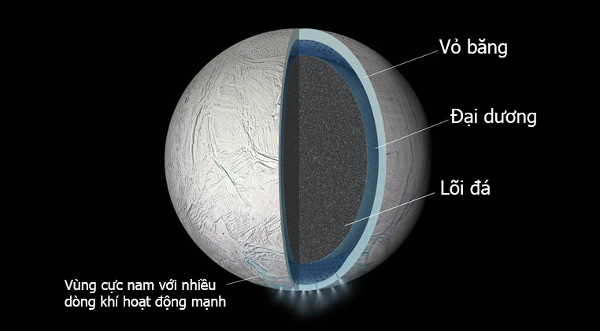There may be an ocean hidden deep beneath the crust of the moon Enceladus
In Saturn's moon Enceladus may contain an ocean - NASA's new discovery after years of image analysis recorded by Cassini. The measurements of this moon's rotation indicate that it is slightly swaying like the natural movement of a raw egg as we rotate it on the table.
In Saturn's moon Enceladus may have a large ocean
This is the latest discovery in a series of studies on the geological activity of the six largest moons of Saturn . The existence of water near the surface, probably a large lake or sea on Enceladus began to be suspected by scientists when Cassini captured vapors of evaporation, ice crystals and simple organic molecules escaping. out from the cracks at the south pole of this moon. However, the changes in gravity of Cassini's moon suggest that deep beneath Enceladus' frozen surface may be a large ocean.
This finding seems to confirm the question of the existence of an ocean originating from independent analytical data about swaying or swinging in the moon's rotation. Enceladus was measured by Cassini. after it invaded the Saturn system and began to fly across the planet's many moons since 2004. To measure Enceladus' swaying motion, the scientists compared many images to one. certain features on the moon, such as craters for many years. With hundreds of images like that, they can measure and conclude that the moon has a slight swing when spinning.

Enceladus is Saturn's largest moon.
According to NASA, the reason for this shaking is partly due to Enceladus's slightly distorted shape and partly due to its elliptical orbit around Saturn. The combination of both creates an unequal pull that Enceladus can change abnormally similar to the motion of the Moon around the Earth. The question is what makes it so swaying and questioning whether it is a completely solid object?
By processing a series of computer models, scientists at NASA said that under the most likely scenario, the lunar intensity of Enceladus is affected by the ice cover and the rock core is separated by a liquid layer . This creates a greater imbalance when the moon rotates, similar to the difference between rotating a boiled egg and a raw egg, the raw egg will wobble by the inner yolk will lose its balance when turn.
Matthew Tiscareno, a scientist from SETI Institute, Mountain View, California, said: "If the surface and core are tightly connected, the core will be able to provide enough dead weight so that the swaying intensity may be smaller. Compared to what we observed, it proved that there must be a layer of liquid separating Enceladus' surface and core ".
Scientists are now looking to determine what makes Enceladus work unlike a frozen ice cube.Saturn's tidal heat is one of many possibilities. To help find the answer, Cassini was scheduled to survey one of the polar air strips at an altitude of about 49km on October 28.
- The giant ocean on Saturn's moon may contain life
- It is possible that life has appeared on the moon Enceladus, which we do not know
- NASA has revealed evidence that extraterrestrial life exists in the Solar System
- Curious with the giant Y on the Moon Enceladus
- 50 images of Saturn's Enceladus moon - where life may exist (Part 2)
- 50 images of Saturn's Enceladus moon - where life can exist (Part 1)
- Detecting sea water on Moon Enceladus of Saturn
- Cassini flies close to the moon of Saturn
- An alien moon that is 'coming of age' produces life
- Hot water lake on Saturn is detected
- Overview of Saturn's moon Enceladus
- Hundreds of water circuits are spraying on Saturn's moon
 Van Allen's belt and evidence that the Apollo 11 mission to the Moon was myth
Van Allen's belt and evidence that the Apollo 11 mission to the Moon was myth The levels of civilization in the universe (Kardashev scale)
The levels of civilization in the universe (Kardashev scale) Today Mars, the sun and the Earth are aligned
Today Mars, the sun and the Earth are aligned The Amazon owner announced a secret plan to build a space base for thousands of people
The Amazon owner announced a secret plan to build a space base for thousands of people James Webb Telescope Discovers Rare Scene From Saturn's Moon
James Webb Telescope Discovers Rare Scene From Saturn's Moon  Alien abyss reveals signs of potential life
Alien abyss reveals signs of potential life  Find your way into the 'water world' that contains alien life?
Find your way into the 'water world' that contains alien life?  NASA has revealed evidence that extraterrestrial life exists in the Solar System
NASA has revealed evidence that extraterrestrial life exists in the Solar System  An alien moon that is 'coming of age' produces life
An alien moon that is 'coming of age' produces life  The giant ocean on Saturn's moon may contain life
The giant ocean on Saturn's moon may contain life 